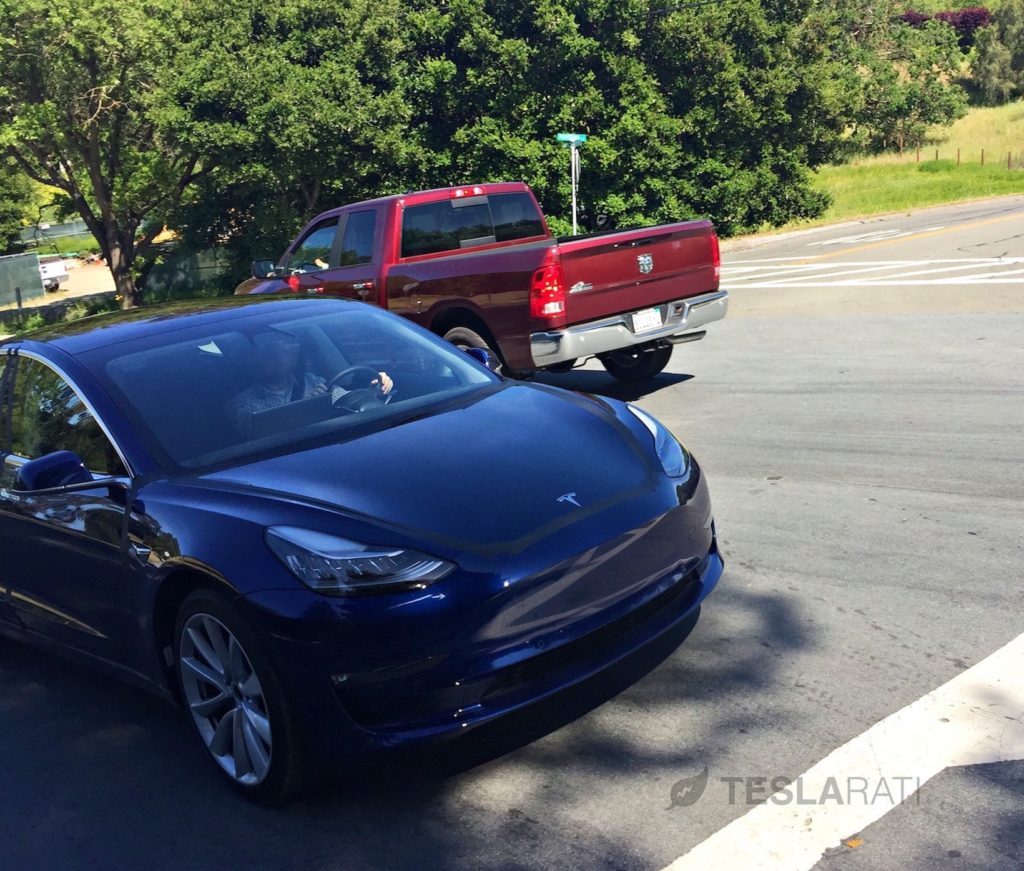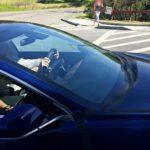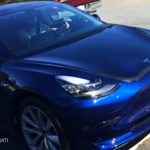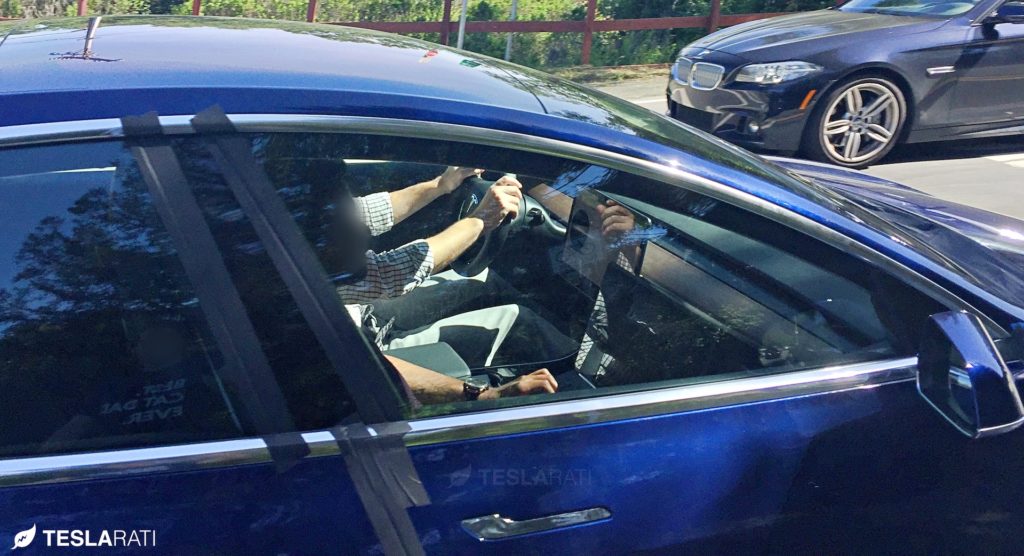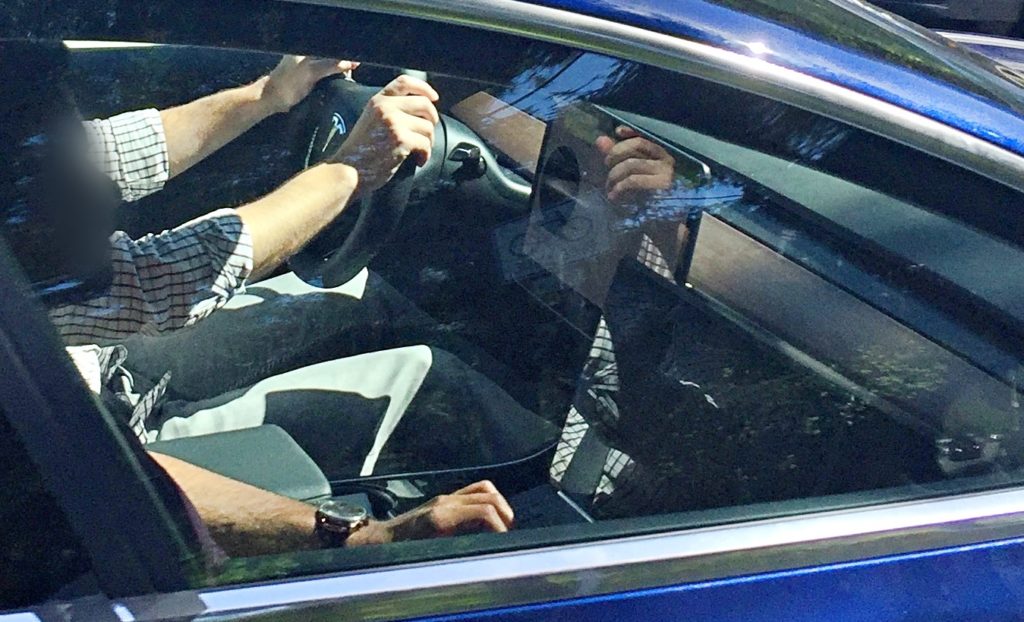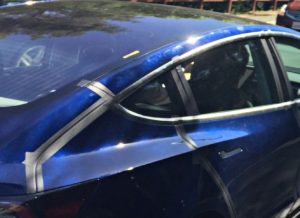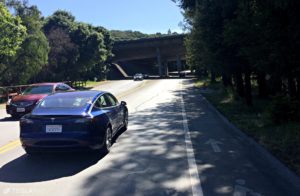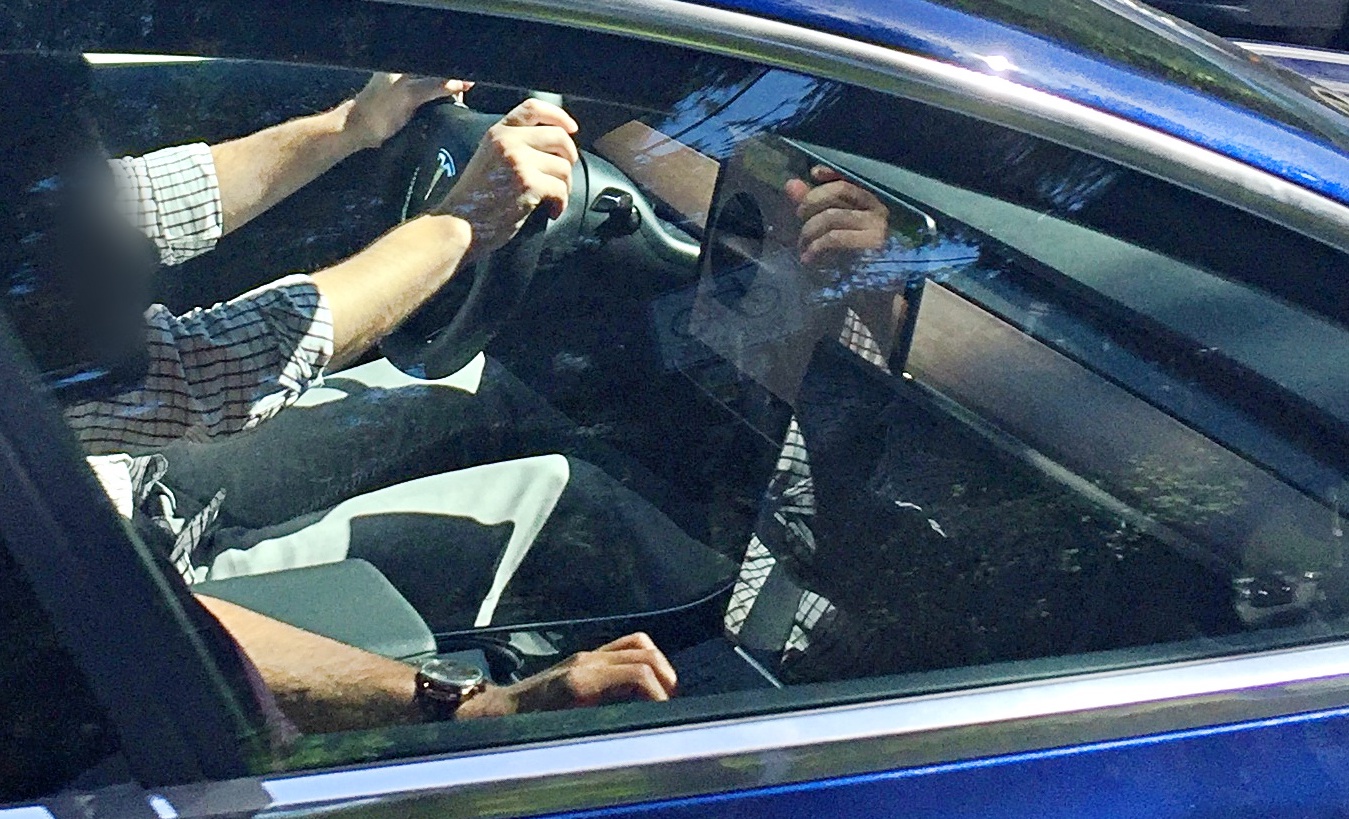
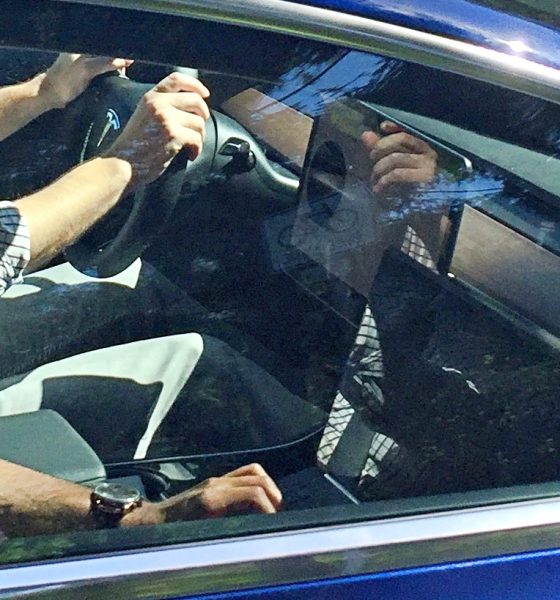
News
First close-up look at Tesla’s Model 3 interior in production-ready form
Following this week’s sighting of a very refined looking blue Tesla Model 3 driving near the company’s Silicon Valley headquarters, the vehicle was sighted once again this time giving us a first close-up look at a very production-ready Model 3 interior.
The blue Tesla Model 3 was spotted on Thursday shortly before 4pm local time driving away from Tesla HQ and coming to a stop at the intersection of Arastradero road and Purrsima. It’s the very same road we first captured on video a black Model 3 doing a very spirited drive with a BMW chase car. However, unlike previous sightings of the highly anticipated electric car, Thursday’s sighting takes place while being directly next to the vehicle.
Teslarati obtained the following never-before-seen photos showing a close-up look at what’s presumably the final version of the Model 3 dashboard. As noted by Chief Elon Musk earlier this month, the dashboard doesn’t have a heads up display – much to the disappointment of HUD hopefuls worldwide. Noticeably present is the large landscape mounted center infotainment system which will also act as the main command center to the vehicle. The thin touchscreen device framed by what appears to be a hard plastic bezel with rounded corners rests several inches away from a shallow dashboard.
Tesla Model 3 drivers will not have an instrument cluster with speedometer. After all, Elon Musk says “you won’t care“. Nor will there be a “hump” on the dashboard in front of the steering wheel. Some Tesla community members speculated that there would be some form of an instrument cluster, after seeing a rounded dashboard protrusion appear on a rendering showing a Tesla Model 3 under a Supercharger with solar canopy.
In its place is a streamlined and simple looking horizontal strip of seemingly functionless interior trim. With the expectation that Model 3 will one day be fully self-driving, Tesla could eventually use the area as a storage compartment for passengers in the non-driving driver’s seat.
A large digital readout resembling that of an oversized analog speedometer appears on the left side of the infotainment system and occupies nearly a third of the overall screen size.
Also seen in our spy shots is a bamboo style interior finish that’s currently not available on either the Model S or Model X. The interior trim decor is angled on a downward slope away from the vehicle’s ventilation system that’s located directly above and runs the full width of the dashboard.
We’re also getting a clear look at how the steering wheel is mounted which swoops in and around the bottom section of the dashboard.
The center console of the Model 3 remains largely the same as early Alpha cars that we’ve seen. Two cupholders have been provisioned into the center console storage unit which appears to have pull handles similar to that of the Model S and Model X console.
Lastly, we’re seeing what appears to be the final trunk and glass roof design. Though black tape is seen across the entire car masking off any gaps between body panels and doors – presumably as engineers perform quality assurance wind testing – the Model 3, overall, appears to be very well-finished.
The rear defroster lines can be seen on the rear windshield leading to two unknown circular marks on the glass roof. A horizontal rear brake light can be seen mounted towards the bottom of the rear windshield.
Musk has said that the first deliveries of Model 3 will be the simpler rear wheel drive configuration followed by the dual motor variant and performance version in late 2017 and into 2018. With only a couple of months left before Tesla is expected to begin low volume production of the first Model 3 variants, we suspect that there will be very few updates, if any, to come. Tesla is expected to hold a Model 3 launch event in July.
Have you spotted a Model 3? Be sure to send us a tip at tips@teslarati.com or DM us on @Twitter or Facebook.
A big thanks to Wayne for providing Teslarati with the following exclusive photos. We’ve stitched together Wayne’s photos to create an animation that shows his perspective of the oncoming Model 3.


News
Tesla starts showing how FSD will change lives in Europe
Local officials tested the system on narrow country roads and were impressed by FSD’s smooth, human-like driving, with some calling the service a game-changer for everyday life in areas that are far from urban centers.

Tesla has launched Europe’s first public shuttle service using Full Self-Driving (Supervised) in the rural Eifelkreis Bitburg-Prüm region of Germany, demonstrating how the technology can restore independence and mobility for people who struggle with limited transport options.
Local officials tested the system on narrow country roads and were impressed by FSD’s smooth, human-like driving, with some calling the service a game-changer for everyday life in areas that are far from urban centers.
Officials see real impact on rural residents
Arzfeld Mayor Johannes Kuhl and District Administrator Andreas Kruppert personally tested the Tesla shuttle service. This allowed them to see just how well FSD navigated winding lanes and rural roads confidently. Kruppert said, “Autonomous driving sounds like science fiction to many, but we simply see here that it works totally well in rural regions too.” Kuhl, for his part, also noted that FSD “feels like a very experienced driver.”
The pilot complements the area’s “Citizen Bus” program, which provides on-demand rides for elderly residents who can no longer drive themselves. Tesla Europe shared a video of a demonstration of the service, highlighting how FSD gives people their freedom back, even in places where public transport is not as prevalent.
What the Ministry for Economic Affairs and Transport says
Rhineland-Palatinate’s Minister Daniela Schmitt supported the project, praising the collaboration that made this “first of its kind in Europe” possible. As per the ministry, the rural rollout for the service shows FSD’s potential beyond major cities, and it delivers tangible benefits like grocery runs, doctor visits, and social connections for isolated residents.
“Reliable and flexible mobility is especially vital in rural areas. With the launch of a shuttle service using self-driving vehicles (FSD supervised) by Tesla in the Eifelkreis Bitburg-Prüm, an innovative pilot project is now getting underway that complements local community bus services. It is the first project of its kind in Europe.
“The result is a real gain for rural mobility: greater accessibility, more flexibility and tangible benefits for everyday life. A strong signal for innovation, cooperation and future-oriented mobility beyond urban centers,” the ministry wrote in a LinkedIn post.
News
Tesla China quietly posts Robotaxi-related job listing
Tesla China is currently seeking a Low Voltage Electrical Engineer to work on circuit board design for the company’s autonomous vehicles.

Tesla has posted a new job listing in Shanghai explicitly tied to its Robotaxi program, fueling speculation that the company is preparing to launch its dedicated autonomous ride-hailing service in China.
As noted in the listing, Tesla China is currently seeking a Low Voltage Electrical Engineer to work on circuit board design for the company’s autonomous vehicles.
Robotaxi-specific role
The listing, which was shared on social media platform X by industry watcher @tslaming, suggested that Tesla China is looking to fill the role urgently. The job listing itself specifically mentions that the person hired for the role will be working on the Low Voltage Hardware team, which would design the circuit boards that would serve as the nervous system of the Robotaxi.
Key tasks for the role, as indicated in the job listing, include collaboration with PCB layout, firmware, mechanical, program management, and validation teams, among other responsibilities. The role is based in Shanghai.
China Robotaxi launch
China represents a massive potential market for robotaxis, with its dense urban centers and supportive policies in select cities. Tesla has limited permission to roll out FSD in the country, though despite this, its vehicles have been hailed as among the best in the market when it comes to autonomous features. So far, at least, it appears that China supports Tesla’s FSD and Robotaxi rollout.
This was hinted at in November, when Tesla brought the Cybercab to the 8th China International Import Expo (CIIE) in Shanghai, marking the first time that the autonomous two-seater was brought to the Asia-Pacific region. The vehicle, despite not having a release date in China, received a significant amount of interest among the event’s attendees.
Elon Musk
Elon Musk and Tesla AI Director share insights after empty driver seat Robotaxi rides
The executives’ unoccupied tests hint at the rapid progress of Tesla’s unsupervised Robotaxi efforts.

Tesla CEO Elon Musk and AI Director Ashok Elluswamy celebrated Christmas Eve by sharing personal experiences with Robotaxi vehicles that had no safety monitor or occupant in the driver’s seat. Musk described the system’s “perfect driving” around Austin, while Elluswamy posted video from the back seat, calling it “an amazing experience.”
The executives’ unoccupied tests hint at the rapid progress of Tesla’s unsupervised Robotaxi efforts.
Elon and Ashok’s firsthand Robotaxi insights
Prior to Musk and the Tesla AI Director’s posts, sightings of unmanned Teslas navigating public roads were widely shared on social media. One such vehicle was spotted in Austin, Texas, which Elon Musk acknowleged by stating that “Testing is underway with no occupants in the car.”
Based on his Christmas Eve post, Musk seemed to have tested an unmanned Tesla himself. “A Tesla with no safety monitor in the car and me sitting in the passenger seat took me all around Austin on Sunday with perfect driving,” Musk wrote in his post.
Elluswamy responded with a 2-minute video showing himself in the rear of an unmanned Tesla. The video featured the vehicle’s empty front seats, as well as its smooth handling through real-world traffic. He captioned his video with the words, “It’s an amazing experience!”
Towards Unsupervised operations
During an xAI Hackathon earlier this month, Elon Musk mentioned that Tesla owed be removing Safety Monitors from its Robotaxis in Austin in just three weeks. “Unsupervised is pretty much solved at this point. So there will be Tesla Robotaxis operating in Austin with no one in them. Not even anyone in the passenger seat in about three weeks,” he said. Musk echoed similar estimates at the 2025 Annual Shareholder Meeting and the Q3 2025 earnings call.
Considering the insights that were posted Musk and Elluswamy, it does appear that Tesla is working hard towards operating its Robotaxis with no safety monitors. This is quite impressive considering that the service was launched just earlier this year.
